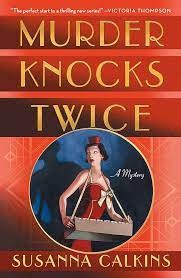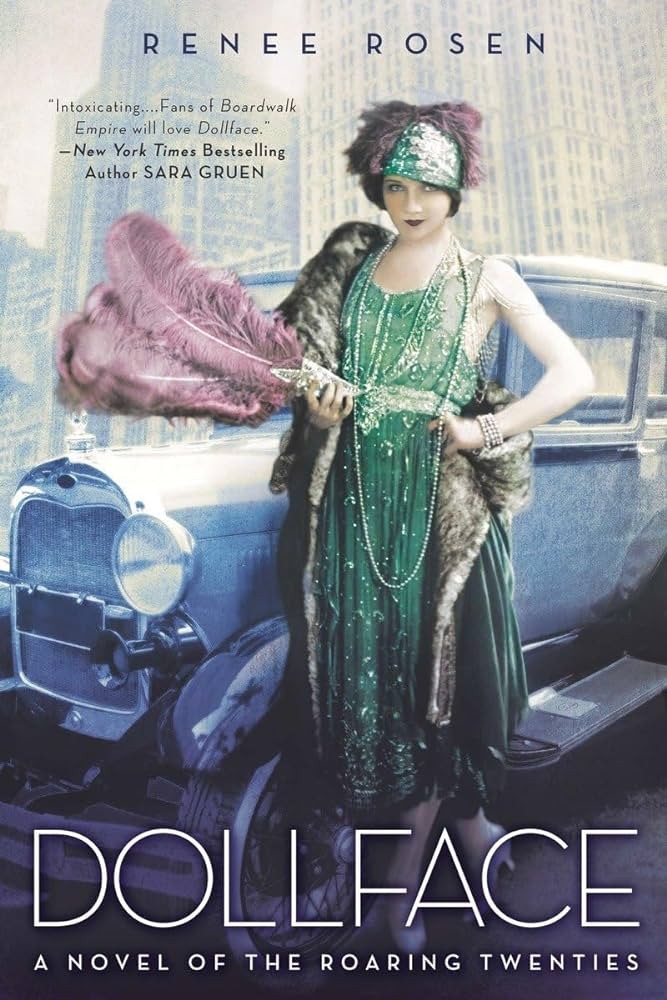Roaring Chicago
Wednesday, January 24, 2024
Chicago provides a fertile landscape for literature, perhaps even more in the 1920s than now. The considerable body of literature set in that era includes Beer Wars, flappers, jazz and blues, and all other celebrated aspects of that post-War, pre-Depression historical time. But the best historical novels seek a higher ground, often exploring the rich tapestry of struggle beneath the gay surface. Here is a list of worthwhile 1920s fiction set in Chicago.
1. The Great Gatsby, by F. Scott Fitzgerald (Published: April 10, 1925)
 F. Scott Fitzgerald's classic novel is set in New York, but is peppered with Chicago influences and references. Jay Gatsby’s mission in life is to win back the love of his life, Daisy Buchanan. Gatsby’s ostentatious show of wealth and influence attempt to prove his worthiness as a provider and elevate his class status. Gatsby’s luxurious front lawn serves as a kind of open party in which the music, fashion, dance, drink, and style of the Jazz Age feature prominently. This story displays all the decadence and carelessness of a long-gone era. The novel’s famous final line summarizes Gatsby’s hopeless chase. “And so we beat on, boats against the current, borne back ceaselessly into the past."
F. Scott Fitzgerald's classic novel is set in New York, but is peppered with Chicago influences and references. Jay Gatsby’s mission in life is to win back the love of his life, Daisy Buchanan. Gatsby’s ostentatious show of wealth and influence attempt to prove his worthiness as a provider and elevate his class status. Gatsby’s luxurious front lawn serves as a kind of open party in which the music, fashion, dance, drink, and style of the Jazz Age feature prominently. This story displays all the decadence and carelessness of a long-gone era. The novel’s famous final line summarizes Gatsby’s hopeless chase. “And so we beat on, boats against the current, borne back ceaselessly into the past."
Several characters appear to be modeled upon Fitzgerald's Chicago aquaintances, including Daisy, Tom Buchanan, and Jordan Baker. Narrator Nick Carraway claims, “Daisy was popular in Chicago, as you know. They moved with a fast crowd, all of them young and rich and wild, but she came out with an absolutely perfect reputation. Perhaps because she doesn't drink.”
Gatsby himself is in a murky business relationship with Meyer Wolfsheim—the two have allegedly bought a series of drug stores in Chicago and Gatsby fields several business-related phone calls from Chicago. Wolfsheim fixed the 1919 World Series, which of course involved the Chicago White Sox. Gatsby’s roots are also in Chicago, which we know because his father, Henry C. Gatz, learns of his son’s death in the Chicago newspapers.
Nick finally concedes that The Great Gatsby is a story less about New York and more about Chicago and other places from which its characters formed their values. He writes, “I see now that this has been a story of the West, after all--Tom and Gatsby, Daisy and Jordan and I, were all Westerners, and perhaps we possessed some deficiency in common which made us subtly unadaptable to Eastern life.” Nick’s use of “the West” is outdated and would translate today to “the Midwest.”
2. Wild Women and the Blues, by Denny S. Bryce (Published: March 30, 2021)
Bryce’s debut novel toggles between two timelines, successfully weaving the surface story of a film student’s interactions with Honoree Dalcour in a Bronzeville nursing home in 2015, and the former chorus girl’s activities up and down “The Stroll” in 1925. Honoree, still sprightly at 110 years old, is among the last witnesses to a vibrant, dangerous era nine decades in the past. The story of Honoree’s struggle to graduate from the disheveled Miss Hattie’s Garden Cafe to the glamourous Dreamland Café, mixed up with romance, deception, and murder, makes for a compelling backstory. Grieving Sawyer Hayes, trying to overcome the guilt and sadness he experienced as the driver in an accident that killed his sister, needs this thesis project to help his recovery. Sawyer is literally and figuratively chasing ghosts, and in her own way so is Honoree. The unlikely pair find their way, together, into something that resembles closure, or at least self-forgiveness. Wild Women was a two-time finalist for the Romance Writers of America’s Golden Heart Award.
Bryce attended Lake Forest College and stayed many years in the Chicago area afterward, living in Oak Park, Hyde Park, and Lincoln Park, among other neighborhoods. Though Bryce no longer performs, she started as a ballet dancer before moving into modern and then some jazz dance. She performed at the Goodman Theatre and worked in a dance studio above the Biograph Theater. She transferred her experience, along with research, to her 1920s story, in which the chorus lines, high-energy dance floors, and changing rooms help situate us in that intense time period. Bryce also homes in on the era’s music. “As part of my research, I listened to the songs of the day, especially the blues singers like Bessie Smith, Alberta Hunter, and [Lil Hardin Armstong],” Bryce told me. “Women got to do more things on their own in the 20s--go into bars, drink, have a cigarette.”
3. Murder Knocks Twice, by Susanna Calkins (Published: April 30, 2019)
In Calkin’s first (of two) installments in The Speakeasy Murders series, Gina Ricci takes on a second job as cigarette girl in the infamous “moonshine parlor,” the Third Door. She becomes immersed in the grit and glamour of life in Prohibition-era Chicago. Murder Knocks Twice teems with the atmosphere of 1929 Chicago’s underground social scene, as Gina attempts to solve the mystery of her predecessor’s death. The novel was an Agatha Award and Lefty Award nominee, both for best historical mysteries. Calkin writes expertly on Chicago as a particular place, rather than backdrop, as in a scene in which our heroine enters a speakeasy off Halsted Street for the first time. “Gina looked around. They had entered a small room with a single lightbulb swinging above the entranceway, casting shadows on the cracked and peeling walls. As her eyes adjusted to the light, she could make out a closed door marked TEA ROOM ENTRANCE to her right, and another doorway at the far end of the room. A tall stool was in the corner by the green alley door, and at eye level there was a peephole from which a faint line of sunlight flowed.” Calkins specialized in 17th century London as a PhD in history and expanded her research in the writing of her seven-book Lucy Campion series. She found the possibilities of a Chicago setting exhilarating, especially its extensive tunnel system. She also loved the period cocktails. "I did a lot of 'cocktail research,' " Calkins said. "There was this awesome book of 100 Prohibition Era Cocktails, or something like that. I had a neighbor who was a bartender. We did about 35 and then I got to the ones with absinthe and lots of eggs, and I thought, 'I’ve tried the ones I wanted to try.' " For the record, Calkins ranks the Gin Rickey, Bee's Knees, and Aviation as her favorites.
parlor,” the Third Door. She becomes immersed in the grit and glamour of life in Prohibition-era Chicago. Murder Knocks Twice teems with the atmosphere of 1929 Chicago’s underground social scene, as Gina attempts to solve the mystery of her predecessor’s death. The novel was an Agatha Award and Lefty Award nominee, both for best historical mysteries. Calkin writes expertly on Chicago as a particular place, rather than backdrop, as in a scene in which our heroine enters a speakeasy off Halsted Street for the first time. “Gina looked around. They had entered a small room with a single lightbulb swinging above the entranceway, casting shadows on the cracked and peeling walls. As her eyes adjusted to the light, she could make out a closed door marked TEA ROOM ENTRANCE to her right, and another doorway at the far end of the room. A tall stool was in the corner by the green alley door, and at eye level there was a peephole from which a faint line of sunlight flowed.” Calkins specialized in 17th century London as a PhD in history and expanded her research in the writing of her seven-book Lucy Campion series. She found the possibilities of a Chicago setting exhilarating, especially its extensive tunnel system. She also loved the period cocktails. "I did a lot of 'cocktail research,' " Calkins said. "There was this awesome book of 100 Prohibition Era Cocktails, or something like that. I had a neighbor who was a bartender. We did about 35 and then I got to the ones with absinthe and lots of eggs, and I thought, 'I’ve tried the ones I wanted to try.' " For the record, Calkins ranks the Gin Rickey, Bee's Knees, and Aviation as her favorites.
4. The Fate of a Flapper, by Susanna Calkins (Published: July 8, 2020)
Gina Ricci picks up where she left off, this time using her newfound photography skills at a crime scene that involves a Third Door customer. This is again 1929, with the Chicago Cubs taking on the Philadelphia Athletics in the World Series. Gina’s initial attempt is to help her female police officer cousin gain traction in her male-dominated profession; it soon turns into a moral dilemma of a mystery involving potentially tainted liquor. This novel contains plenty of Jazz Age atmosphere, but the general conceit also allows ample exploration of 20s-style feminism. The novel is at its best in depicting that era’s unseemly side. “The local cops didn’t police Prohibition; they only arrested drunks if they were publicly disorderly or committing a crime. If treated gingerly, they were usually willing to accept a payoff—or even a drink.” It is also strong on Chicago historical details, like, “Ninety-five bombs detonated in Chicago this year alone. Pineapple bombs, black powder bombs, dynamite, Molotov cocktails . . . there seemed to be no shortage in the ways people sought to terrorize one another. Bootleggers and businessmen alike, even a college quarterback, of all people, had been threatened by bombs. The side effects of skills learned during the Great War.”
5. Chicago, by David Mamet (Published: Feb. 27, 2018)
David Mamet’s fictional return to his hometown is a dense, masculine, sometime cliched romp among Chicago Tribune newsmen, rival gangs, Black whorehouses, and more. Chicago’s interest lies much more in the violence than glamour of the era. World War II veteran and reporter Mike Hodge knows Chicago’s underbelly—the musicians, the politicians, the gangsters, the prostitutes, the con men—but his cynicism does not stop him from falling in love. His paramour, Annie Walsh, comes from a family in bed with The Mob, and when she winds up dead Hodge’s story takes a dangerous, interesting turn. Fans of Mamet’s previous work, as the scriptwriter for The Untouchables, for example, will delight in his use of language—he sprinkles together sophisticated vocabulary and street vernacular in ways other writers could not pull off. One newspaper man, over drinks, declares, “A newspaper is a joke. Existing at the pleasure of the advertisers, to mulct the public, gratifying their stupidity, and render some small advance on investments to the owners, offering putative employment to their etiolated, wastrel sons, in those young solons’ circuit between the Fort Dearborn Club and the Everleigh House of Instruction.” To which another newspaper man responses, “Well, fuck you.”
6. The Mayor of Maxwell Street, by Avery Cunningham (Publication Date: Jan. 30, 2024)
Cunningham’s debut novel, The Mayor of Maxwell Street, is an historical novel involving a Southern Black family’s “season” in 1921 Chicago. It’s a sweeping, twisting, complex story that grounds its big ideas in a Chicago as much murderous as it is marvelous. “Season” is a fancy term used by wealthy people. Think Jane Austen’s world. Indeed, the ballrooms of Cunningham’s novel rival those of any Victorian romance. That this grandeur belongs to Black people should not be surprising, but as a literary depiction it’s somewhat rare. Cunningham’s novel deftly shows that there are many facets to the Black experience. In plotting The Mayor of Maxwell Street, Cunningham knew she wanted to defy the usual media depictions of Black people in distress. She said she “wanted to explore all of the complexities of that Black high society--colorism, classicism, internal biases, conflict between academic and nouveau riche spheres of influence…” This exploration does not in any way deny social injustice, but frames it in a different way, with somewhat different manifestations. And Cunningham’s novel certainly makes a bunch of hard turns away from that proper, glittery society—into Chicago’s alleyways and underground clubs and mythical bazaars. The author’s heroine, on assignment with the The Defender, introduces us to all manner of Chicago’s people and places as she chases down a dangerous but important story.
Cunningham told me that The Great Gatsby was her initial inspiration for her debut novel, specifically the line: “I was within and without, simultaneously enchanted and repelled by the inexhaustible variety of life.” When I asked her what surprising discoveries she made during her historical research, she told me, “Something I loved uncovering was the violent feud between the Yellow Cab taxi company and the Checkers taxi company. In the early 1920s, blood was spilled between the two groups in a kind of turf war. And while that may seem like a silly detail, it is so unique to Chicago and the fever pitch of the ‘20s that it demands to be shared.”
7. Dollface: A Novel of the Roaring Twenties, by Renée Rosen (Published: Nov. 5, 2013)
 The Roaring 20s, in Chicago and elsewhere in America, represented opportunity, or freedom, especially for women. The decade started with the passage of the 19th Amendment and with it a sense that women were equals. The reality, though, was that women were still at the mercy of men who controlled much of their lives. Vera Abramowitz is very much a woman of the 20s. She rejects a family life that includes working in her mother’s Stock Yards kosher meatpacking plant. She instead moves into a boarding house and finds a job as a typist. Vera knew violence--her father was killed by the notorious Black Hand mob. Along with her friend Evelyn, Vera finds the spirit of the decade bracing, perhaps seductive, and with bobbed hair and flapper dresses the pair wind their way through Chicago’s speakeasies on a crash course with another class of emboldened citizens: the gangsters. In a story that begins in 1922 and ends with Repeal in 1933, Vera rises from drab office clerk to glittery gun mole. Vera becomes involved with rival gangsters, a gambler working under Al Capone and a nightclub owner in control of the North Side gang. Eventually, Vera becomes pregnant with Tony’s baby, but marries Shep and settles into an affluent life as a mob wife. In addition to Evelyn, Vera befriends other gun molls. Eventually, Vera’s relative wealth and elevated status cannot shield her from the escalating violence between warring criminal factions.
The Roaring 20s, in Chicago and elsewhere in America, represented opportunity, or freedom, especially for women. The decade started with the passage of the 19th Amendment and with it a sense that women were equals. The reality, though, was that women were still at the mercy of men who controlled much of their lives. Vera Abramowitz is very much a woman of the 20s. She rejects a family life that includes working in her mother’s Stock Yards kosher meatpacking plant. She instead moves into a boarding house and finds a job as a typist. Vera knew violence--her father was killed by the notorious Black Hand mob. Along with her friend Evelyn, Vera finds the spirit of the decade bracing, perhaps seductive, and with bobbed hair and flapper dresses the pair wind their way through Chicago’s speakeasies on a crash course with another class of emboldened citizens: the gangsters. In a story that begins in 1922 and ends with Repeal in 1933, Vera rises from drab office clerk to glittery gun mole. Vera becomes involved with rival gangsters, a gambler working under Al Capone and a nightclub owner in control of the North Side gang. Eventually, Vera becomes pregnant with Tony’s baby, but marries Shep and settles into an affluent life as a mob wife. In addition to Evelyn, Vera befriends other gun molls. Eventually, Vera’s relative wealth and elevated status cannot shield her from the escalating violence between warring criminal factions.
Rosen is a master of the historical novel, and part of what makes her so is her diligent, intense research into her settings. She took a gangster bus tour with Craig Alton, who shared his knowledge and also escorted Rosen on a tour of Chicago’s last slaughterhouse, Chiappetti. She Interviewed Capone’s great niece. She went to look at the bullet hole in Holy Name Cathedral, where “Hymie” Weiss was shot. She surveyed the skeletal remains of places like the Four Deuces and the St. Valentine’s Day Massacre garage. She also listened to many stories. “Everybody had some great aunt who was a gun moll,” Rosen said. “Throughout history, women have loved bad boys. These were tough broads that dabbled in a little bit of danger. There was a lot of glitz and glamour; if you knew where to go there was always a party going on. It was a very liberating time for women. They were smoking, they were drinking, they were showing their knees.”
8. The Jazz Palace, by Mary Morris (Publication Date: April 7, 2015)https://www.marymorris.net/
Peter Orner calls The Jazz Palace “an exquisite love letter to [Morris’s] home town.” When the Lehman family loses son Harold to a blizzard, it becomes the responsibility of the sole surviving male, Benny, to take over their hat-manufacturing business. But Benny wants to play jazz, not make hats. Likewise, the Chimbrovas hope one of their surviving children take over the family saloon after three sons died in the S.S. Eastland tragedy. It is Pearl Chimbrova’s saloon, “The Jazz Palace,” where Benny finds his calling. The novel’s core interest is in the struggle of outsiders—a first-generation Jewish character and an orphaned Black character, among them. Morris splices real historical events into the recreated setting, always with purpose. There is plenty of rich Chicago period details here, and plenty of mob joints, flappers, and the like. Where Morris really excels, though, is in the way she captures the intensity--the joy and the sorrow--of the music. The Jazz Palace won the 2016 Anisfield-Wolf Award For Fiction.
9. Dead Man’s Blues, by Ray Celestin (Published: July 26, 2016)
This novel, set in the oppressively hot summer of 1928, starts with a Mafia funeral. Soon, we learn that several deaths and a possible kidnapping have all taken place around the same time: a poisoning of Chicago politicians at an upscale hotel, the mutilation of a white gangster in a Blackbelt alleyway, and the disappearance of a celebrated heiress. Pinkerton detectives enlist the help of Louis Armstrong to help find the heiress, at the same time that a crime scene photographer feels compelled to investigate the mutilated man's murder and Al Capone's fixer looks for a traitor in the gang's ranks.
Donald G. Evans is the author of a novel and story collection, as well as the editor of two anthologies of Chicago literature, most recently Wherever I’m At: An Anthology of Chicago Poetry. He is the Founding Executive Director of the Chicago Literary Hall of Fame.








